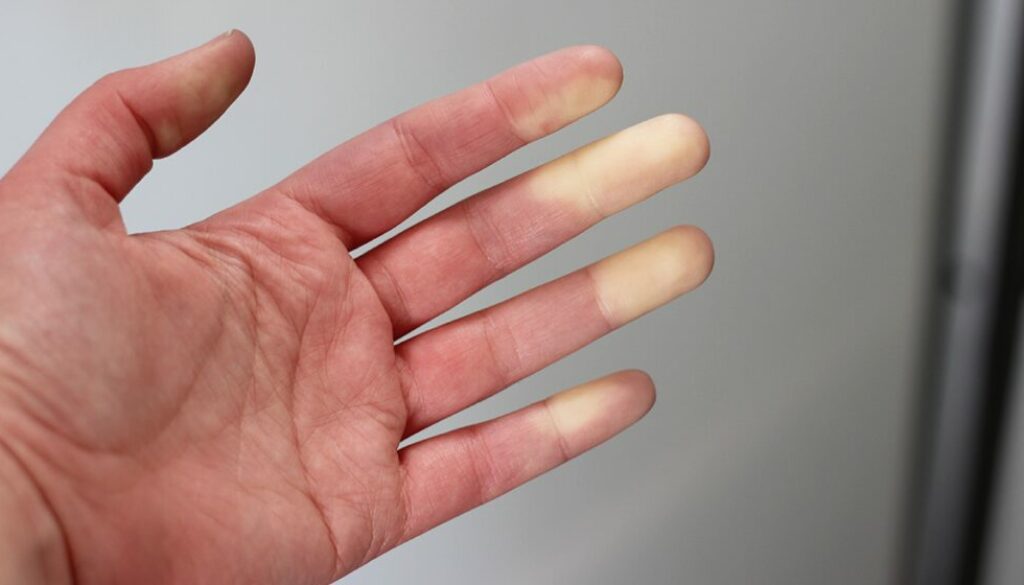Raynaud’s phenomenon, often referred to as Raynaud’s disease, is a condition in which the small blood vessels in certain areas of the body—most commonly the fingers and toes—overreact to cold temperatures or emotional stress, causing a distinct change in color. While some people might notice their fingertips turning white, others may experience a bluish or reddish discoloration, especially during periods of low temperatures or heightened anxiety. Though Raynaud’s phenomenon is not typically life-threatening, it can be uncomfortable, distressing, and, in more severe cases, disruptive to one’s daily routine. In this expanded overview, we will explore the nature of Raynaud’s phenomenon, its causes, common symptoms, and potential management strategies.
What Is Raynaud’s Phenomenon?
Raynaud’s phenomenon is a vascular condition named after the French physician Maurice Raynaud, who first described it in the 19th century. It involves episodes of vasospasm in the blood vessels. A vasospasm is a sudden narrowing of the small blood vessels, which reduces blood flow to specific areas of the body. When triggered, these vessels can tighten and constrict to the point that blood flow is drastically diminished, leading to the distinctive color changes: white (or pale) from the lack of blood supply, possibly blue if the area remains deprived of sufficient oxygen, and then red when blood flow resumes.
Most commonly, the episodes occur in response to cold or emotional stress. A cold winter day, a chilly air-conditioned office, or a particularly stressful moment can set off an episode. The phenomenon can affect other extremities such as the toes, nose, ears, or lips, although the fingers are its most frequent target.

Primary vs. Secondary Raynaud’s
Raynaud’s phenomenon is generally classified into two primary types: primary Raynaud’s and secondary Raynaud’s. Understanding the distinction between the two can help individuals and healthcare providers determine the best course of action.
- Primary Raynaud’s (Raynaud’s disease): In this form, there is no underlying health condition causing the vasospasm. It is often considered the milder version of the disorder. Primary Raynaud’s can sometimes run in families and usually manifests in adolescence or early adulthood. It is also more common in women than in men. Many people with primary Raynaud’s manage their symptoms with lifestyle adjustments and rarely require more aggressive interventions.
- Secondary Raynaud’s (Raynaud’s phenomenon): This type is linked to an underlying medical condition or certain medications. Autoimmune or connective tissue diseases such as scleroderma, rheumatoid arthritis, or lupus are known to be associated with secondary Raynaud’s. Infections, thyroid disorders, and even certain injuries can also lead to Raynaud’s-like episodes. In some cases, medications used to treat migraines, cancer, or hypertension might make people more susceptible to vasospasms. Secondary Raynaud’s may be more severe than the primary form, often requiring more specialized treatment.

Common Symptoms and How They Manifest
The hallmark sign of Raynaud’s phenomenon is the color change in affected areas. These color changes typically occur in stages:
- White (Pallor): When exposed to the triggering element—usually cold or stress—the blood flow to the affected area decreases, causing the skin to turn pale or white.
- Blue (Cyanosis): If the blood supply remains limited, the lack of oxygen can cause the fingers, toes, or other areas to develop a bluish tint.
- Red (Hyperemia): As the blood vessels relax and blood flow returns, the affected area may become red and swollen. This phase is often accompanied by sensations of tingling or throbbing pain.
Beyond color changes, people with Raynaud’s phenomenon frequently describe sensations of numbness or pins and needles in the affected areas. Some may find their fingers or toes feel unusually cold or painful until circulation recovers. In mild cases, these episodes may be fleeting and only somewhat uncomfortable. However, more severe episodes can result in significant pain and might even interfere with everyday activities, like typing, buttoning a shirt, or handling small objects.
Who Is at Risk?
While Raynaud’s phenomenon can occur in individuals of any age or gender, several risk factors make certain groups more susceptible:
- Gender: Women are more commonly affected than men.
- Age: Primary Raynaud’s often begins in adolescence or early adulthood.
- Climate: Individuals living in colder climates might experience more frequent or more severe episodes because they encounter more triggers.
- Family History: A family history of Raynaud’s can increase one’s likelihood of having it.
Beyond these, those dealing with certain autoimmune disorders or who take specific medications may be at risk for secondary Raynaud’s. For instance, people with scleroderma or lupus have a higher probability of encountering Raynaud’s as an additional complication of their existing condition.

Impact on Daily Life
Many individuals with mild or moderate Raynaud’s adapt their routines to minimize the discomfort associated with an episode. For instance, layering up in cold environments, running warm water over their hands, or carrying instant hand warmers in purses or pockets can help offset symptoms. Nevertheless, those with more severe episodes may find their productivity or quality of life impacted. If the pain is intense or recurrent, it might limit certain hobbies, physical activities, or even basic daily tasks.
On occasion, a particularly severe or prolonged vasospasm can lead to complications like skin sores or ulcers, though these are relatively rare. Such occurrences underscore the importance of proper management and open communication with healthcare professionals, especially if episodes become debilitating or frequent.
Seeking Medical Help
Although many cases of primary Raynaud’s do not require aggressive treatment, there are specific indicators that warrant a visit to a doctor:
- Severe Pain: If the pain from an episode becomes unbearable or interferes significantly with sleep or work.
- Frequent Episodes: If episodes occur regularly and do not improve with basic preventive measures.
- Potential Secondary Causes: If there is any reason to suspect an underlying condition, such as an autoimmune disease.
A medical professional might perform a range of tests to confirm Raynaud’s, including examining how blood vessels respond to cold or conducting blood tests to rule out associated disorders. Once a diagnosis is made, potential treatments range from lifestyle modifications to prescription medications designed to dilate blood vessels and improve circulation.

Lifestyle Adjustments and Management
Individuals with Raynaud’s can take several proactive steps to manage episodes and reduce discomfort:
- Stay Warm: Dressing in layers and wearing gloves or thick socks can help keep extremities warm. In cold weather, adding thermal protection—especially for the hands, feet, and even the face—can be vital.
- Avoid Sudden Temperature Changes: Gradually adapt to colder settings by easing into them, and consider carrying portable warming tools like instant heat packs.
- Manage Stress: Because stress and anxiety can trigger episodes, incorporating relaxation techniques such as deep breathing exercises, meditation, or yoga can mitigate flare-ups.
- Practice Good Circulation Habits: Simple routines like gentle hand exercises or foot stretches can help maintain blood flow.
- Avoid Smoking or Secondhand Smoke: Nicotine constricts blood vessels, which can worsen Raynaud’s symptoms.
- Be Mindful of Caffeine: Excessive caffeine intake can lead to vasoconstriction, so moderating coffee, tea, and energy drink consumption can be beneficial.
When Medications May Be Necessary
For those with frequent or severe episodes, physicians may recommend pharmacological interventions:
- Calcium Channel Blockers: These medications help to dilate the small blood vessels, thereby improving blood flow and reducing the intensity of episodes.
- Vasodilators: Creams or other medications may be applied to affected areas to relax and widen blood vessels.
- Other Treatments: In rare cases, procedures such as nerve surgery might be considered if standard treatments prove ineffective.
It is important for individuals to have open dialogues with their healthcare providers. Treatment should be personalized, taking into account each person’s overall health profile, potential drug interactions, and lifestyle preferences.

The Role of Support and Awareness
Educating friends, family, and coworkers about Raynaud’s phenomenon can be helpful. Sometimes, it may appear puzzling or even alarming to see someone’s fingers suddenly blanch or turn blue. Explaining the basics can preempt misunderstandings—especially if a friend or colleague notices the color change and is concerned.
In recent years, patient support groups and online communities have emerged, providing a platform for those with Raynaud’s to share experiences, tips, and emotional support. Whether connecting in person or through social media, such interactions can be invaluable for feeling less isolated and for learning practical coping strategies.
Although Raynaud’s phenomenon can be uncomfortable, many people successfully manage their episodes with simple measures like bundling up in cold weather, reducing stress, and maintaining a healthy lifestyle. For those who experience severe or persistent symptoms, seeking medical advice is crucial to rule out secondary causes and explore suitable treatments.
Ongoing research continues to shed light on the mechanisms behind Raynaud’s phenomenon and potential new therapies. Advances in fields such as vascular biology and autoimmune research may, in time, lead to improved diagnostic tools and targeted treatments. Even though Raynaud’s can be disruptive, awareness of triggers and consistent management strategies can help most individuals live relatively unaffected by the condition.

Conclusion
Raynaud’s phenomenon is a widespread condition that affects up to 20% of adults around the globe, though severity varies significantly from person to person. It is most commonly triggered by cold or emotional stress, resulting in a distinct series of color changes—white, sometimes blue, and then red—as blood flow to extremities is temporarily restricted and then restored. While the condition itself often proves mild, those with frequent or intense episodes may find that Raynaud’s interferes with daily life, creating discomfort and concern about potential complications.
Fortunately, a combination of mindful lifestyle choices, protective clothing, possible use of medications, and stress-management techniques can help mitigate the severity of Raynaud’s episodes. Moreover, by discussing any worrisome symptoms with a medical professional, individuals can ensure they receive proper diagnosis and, when necessary, tailored treatment. Ultimately, Raynaud’s phenomenon underscores the importance of being attentive to your body’s reactions to weather, stress, and other factors, reminding us that even everyday occurrences—like a shift in temperature—can have a significant effect on our well-being.
